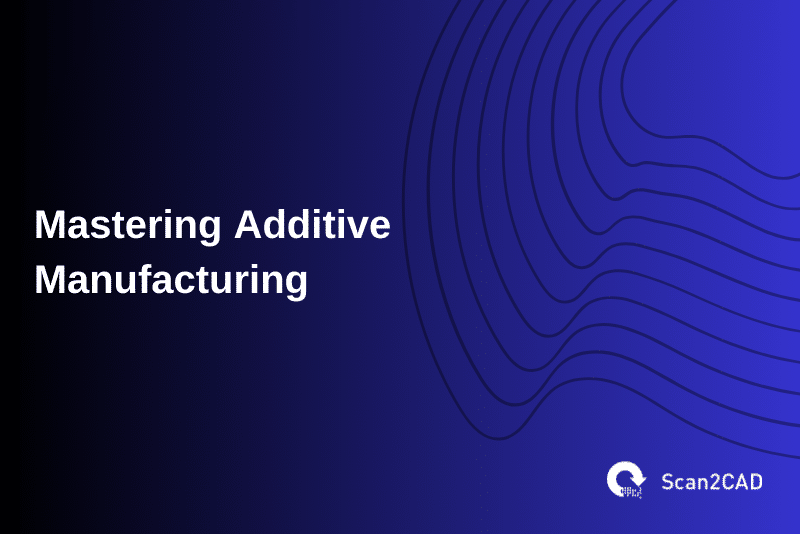While the general population often uses 3D printing (3DP) and additive manufacturing interchangeably, this should not be the case. To most people, 3DP mostly conjures up the image of a manufacturing machine, like a desktop printer or copier, that uses digital files such as 3D CAD models to create objects directly by printing them in three dimensions. Usually, they imagine that such a machine comprises a print head or nozzle that extrudes thin layers of a viscous material (such as heated plastic). When the material, deposited layer by layer, cures and solidifies, it defines the object’s respective shapes.
Indeed, this mental image, which is perhaps influenced by the ubiquity of printing, accurately represents the mechanism behind 3DP. In fact, it corresponds with what the standards body ISO says about the technology: 3D printing is typically associated with machines used for personal use and other non-industrial purposes. So, it goes without saying that 3DP is restricted to the non-industrial creation of objects with a small form factor. This highlights a limitation of 3DP: it does not encompass manufacturing processes used in industrial scenarios for creating objects and parts of both large and small volumes. Instead, we use the term additive manufacturing, which can be referred to by its contracted form AM, to refer to this scenario.
Additive manufacturing addresses the shortcomings of 3DP by more accurately capturing the scale and nature of the fabrication process. In fact, standards bodies and experts use additive manufacturing as the technical and more comprehensive name for both 3DP and rapid prototyping. Put simply, 3D printing and rapid prototyping are subsets of AM. Against this backdrop, what is additive manufacturing? What does it entail? This article answers these and more questions.
Table of Contents
Understanding Additive Manufacturing
What is Additive Manufacturing?
The term additive manufacturing describes a process of using a digital 3D model, generated using 3D CAD software, to fabricate a 3D object directly by joining bulk materials layer upon layer. Historically, the term was referred to by other names, including freeform fabrication, solid freeform fabrication, layer manufacturing, additive layer manufacturing, additive techniques, additive processes, and additive manufacturing. However, today, additive manufacturing is the only accepted term for the process described above.
Additive manufacturing processes utilize machines and systems that manipulate materials, combining them layer upon layer to form a physical object from 3D CAD data. Naturally, this means the process creates a product that did not exist previously or one that is much larger than what was initially present.
Manufacturers use AM to manufacture both production parts and prototypes. When manufacturers use additive manufacturing for the fabrication of end-use components, this process is called Direct Digital Manufacturing (DDM). Improvements in AM technology have led to rapid manufacturing, a category of AM that is fast, accurate and should not be confused with rapid prototyping. Rapid prototyping describes the process through which manufacturers rapidly fabricate representations of the part way before final production and commercialization.
It is worth pointing out that the AM fabrication method makes it possible to fabricate parts and prototypes that have different characteristics. This is because a manufacturer has the liberty to choose among various AM processing methods, each with its own requirements and fabrication technique. Moreover, manufacturers can tweak the process parameters – the operating parameters and system settings used during a single build cycle – to achieve a particular result.
For the best results, additive manufacturing requires manufacturers to have a manufacturing plan. The plan typically comprises process parameters, preparation operations, post-processing tasks, and applicable verification/inspection methods.
General Additive Manufacturing Process
The additive manufacturing process involves eight steps:
- 3D modeling and support 2D design
- Conversion of CAD data to the STL format or AMF format
- Transmission/transfer of converted file to AM machine
- AM machine setup
- Part fabrication
- Part removal from the AM machine and cleaning
- Post-processing, which improves geometrical, surface, and tribological properties (including friction and wear), as well as mechanical characteristics
- Application/use of fabricated product
History of Additive Manufacturing
It is hard to expressly point out the exact year when additive manufacturing was invented. For instance, researchers and builders had, as early as the 1950s and 1960s, already started experimenting with ways to join materials to form objects. Additionally, technologies – like computers, computer-aided design (CAD), computer-aided manufacturing (CAM), computer-numerical computing (CNC), lasers, and programmable logic controllers – that ultimately enabled the realization of additive manufacturing had already been developed or were in development. (At Scan2CAD, we have documented the evolution of CAD and the history of CAM.)
The annals of additive manufacturing nonetheless became more well documented beginning in the 1980s. In 1984, for example, innovators filed parallel patents in Japan, France, and the United States. These patents described a similar concept of creating a 3D object by selectively adding material layer upon layer. One of the patents filed in the United States by Charles Hull is generally regarded as the most consequential because it gave rise to the founding of 3D Systems Corporation. This company still manufactures and sells 3D printers and 3D printing materials.
In 1986, plenty more patents came along, filed by three different companies. These patents described processes such as laminated object manufacturing (LOM), solid ground curing (SGC), and selective laser sintering (SLS). In 1989, fused deposition modeling (FDM) and 3D printing were patented by Scott Crump and a group at MIT, respectively. The former led to the formation of Stratasys Company, while the latter was out-licensed to various companies. What the group at MIT invented is now called binder jetting (BJT). Later, in 1994, inkjet technology, which was used to deposit droplets of material directly onto a base platform (substrate), was developed.
Materials Science: The Heart of Additive Manufacturing
Early additive manufacturing machines and systems made use of materials like paper laminates, photocurable resins, waxes, powders, plastics, and composites. Generally, these were materials that were already available then and had been developed with other processes in mind. However, additive manufacturing had – and still has – pretty unique characteristics and requirements. This meant that these materials were far from ideal for AM.
For instance, when materials such as photocurable resins were used to create products, the products would be brittle and warped easily. Powders that were used in Laser-Based Powder Bed Fusion (LB-PBF) would quickly degrade within the material. This resulted in products that were weaker than expected. Fortunately, these shortcomings have not persisted.
As professionals understood what additive manufacturing entails, they developed materials that suit the various AM processes. Today, there are numerous materials that perfectly match the operating requirements of different processes. These materials include metals, glass, paper, ceramics, composites, bio-inks, graphene-embedded plastics, food, concrete, yarn, etc. The development of these materials has enabled professionals to produce stronger, longer-lasting, more accurate, and well-built parts and prototypes.
Categories of Additive Manufacturing Feedstock
Materials added to additive manufacturing machines before part fabrication commences are known as feedstock. The feedstock can be grouped into three categories:
1. Liquid-Based Materials
Liquid-based materials that are used in additive manufacturing include liquid polymers like Photopolymers and waxes; liquid metals like mercury and melted tin, aluminum, copper, bismuth, etc.; polymeric liquids; and liquid ceramic composite material.
2. Solid-Based Materials
The following solid-based materials can be used in AM machines:
- Solid metal: Wire metal (stainless steels, nickel and copper-nickel alloys, titanium and titanium alloys, cobalt alloys, alloy steels, aluminum alloys, niobium, molybdenum, tungsten, tantalum, zircalloy, and 4340 steel), sheet metal, and strip metal (nickel-based strip metal, mild steel, and stainless steel, copper, titanium, and aluminum)
- Solid ceramic: ceramic tape (sheets or laminates of ceramic powders joined together by polymer binders)
- Solid polymers: thermoplastic polyurethane (TPU) filaments, biopolymers, acrylonitrile butadiene styrene (ABS), polycarbonate (PC), PC-ABS, polylactic acid (PLA), Nylon 6 and 12, polyphenylsulfone (PPSF), polyetherimide (PEI), and polyetherketoneketone (PEKK)
- Solid composites: including metal-metal, metal-ceramic, ceramic-polymer, and ceramic-ceramic material, which are used to create such feedstock as composite laminate, composite polymer filament, particle-reinforced polymer filament, nanomaterial-reinforced polymer filament, fiber-reinforced polymer filament, and solid-based composite wires
3. Powder-Based Materials
Powder-based materials comprise polymer, metal, ceramic, and composite powders. Polymer powders include polyamide, polystyrene, polypropylene, polyaryletherketone (PAEK), thermoplastic polyurethane (TPU), and thermoplastic elastomer (TPE). These powder-based materials can be used as feedstock for powder-based AM processes like BJT, MJT, PBF, and DED.
Additive Manufacturing Processes
There are seven additive manufacturing processes whose selection depends on such factors as cost, accuracy, material properties, and speed:
1. Material Extrusion (MEX)
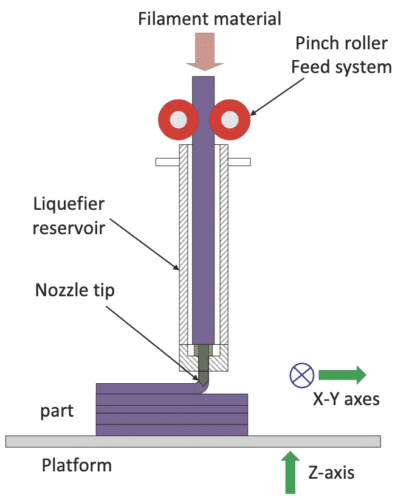
Illustration of the Material Extrusion Process (source)
Typically, in the material extrusion (MEX) process, the feedstock is heated and melted just before or as the machine forces it through a nozzle. The nozzle follows a specific pattern and can control the flow of material. Once it completes a layer, the machine either moves upwards or moves the platform holding the part downwards. This enables it to produce the next layers. MEX machines come in inexpensive packages for hobbyists and personal use, as well as expensive setups for industrial use.
While temperature is the most common method for controlling the state of the feedstock, alternative approaches are also used. This approach entails using a chemical reaction to trigger solidification. This means the material starts out as a paste. A curing agent, residual solvent, drying, or reaction with air causes the paste to cure or dry out.
Common MEX materials include solid polymers like ABS (acrylonitrile butadiene styrene), ULTEM 9085, polyphenylsulfone (PPSF), and polycarbonate (PC), as well as fiber-reinforced filaments like carbon fiber, fiberglass, and Kevlar filaments.
2. Vat Photopolymerization (VPP)
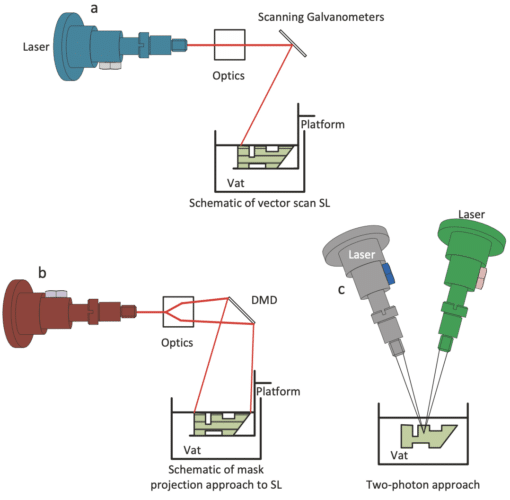
Illustration of the Vat Photopolymerization Process (source)
Vat photopolymerization (VPP), which includes the prominent stereolithography process, is a type of photopolymerization. Photopolymerization uses liquid polymers, or photopolymers, that solidify in response to radiation sources such as UV, gamma rays, electron beams, and sometimes visible light.
In VPP, the photopolymer is placed inside a container called a vat. The material is then exposed to repeated patterns of radiation that correspond to the cross-sections of the product being fabricated. By emitting radiation in repeated patterns of known shape, VPP facilitates the layered solidification of the photopolymer. In addition to photopolymers, resins called epoxides are also used as materials in both stereolithography and VPP. Another class of feedstock, liquid ceramic materials that are a mixture of toughening agents, liquid resin, and powder, can also be used.
3. Powder Bed Fusion (PBF)
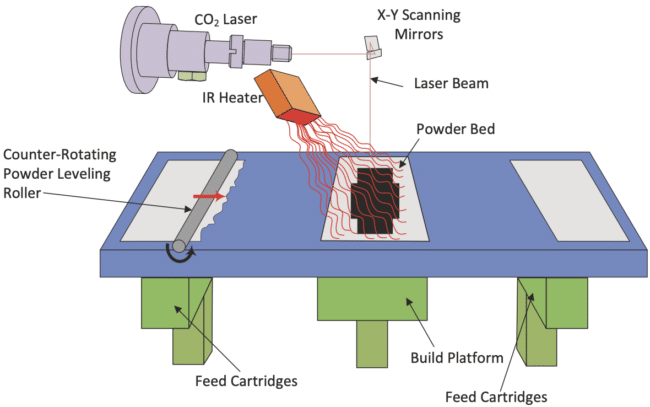
Illustration of the Selective Laser Sintering Process (source)
Powder Bed Fusion, or PBF, is one of the most versatile additive manufacturing processes. Not only is it well suited for metals (metal powders) and polymers, but it can also use composites and ceramics as feedstock.
Generally, PBF uses one or more heat sources, such as lasers (the most common) or electron beams, to fuse powder particles. The entire process occurs in an enclosed chamber filled with nitrogen gas, which helps minimize degradation and oxidation of the powdered material. The chamber is fitted with various sources of heat that elevate the temperature around the part, increase the temperature of the build platform, and preheat the powder to just below its melting point. The elevated temperatures prevent the part from warping and minimize the laser power requirements.
Once the preheated powder is laid on the heated build platform, it forms an appropriate powder layer. Next, a laser beam is directed onto the platform. The beam is moved such that it follows a pattern that forms a slice of the part’s desired cross-section. The surrounding unfused powder remains loose.
The loose powder subsequently supports the layers that are laid above it. Once this layer is complete, the build platform is lowered by one layer, and a new powder platform is laid. This time, the fused and unfused powder become the primary supports for the new layer. The laser beam is again focused. This process is repeated until the part is fabricated. Then, the part is removed from the platform, and the loose powder is cleaned off. Finally, post-processing activities follow.
Under PBF, we have processes like:
- Selective Laser Sintering (SLS), the first commercialized PBF process
- Polymer laser sintering (pLS)
- Metal laser sintering (mLS)
- Laser-Based Powder Bed Fusion (LB-PBF)
4. Material Jetting (MJT)
In Material Jetting (MJT), a printing head dispenses part material following a predefined path that defines the cross-section of the part. Motion controllers, which are part of the MJT machine, control the movement of the head along the path. This ensures the accurate deposition of materials such as polymers, ceramics, metals (tin, bismuth, copper, aluminum, mercury, etc.), and waxes.
The process uses deposition methods like inkjet deposition, multi-jet modeling, cold spray additive manufacturing (CSAM), and metal droplet printing, just to mention a few. Nonetheless, companies are continuously innovating, meaning they may develop additional methods in the future.
5. Binder Jetting (BJT)
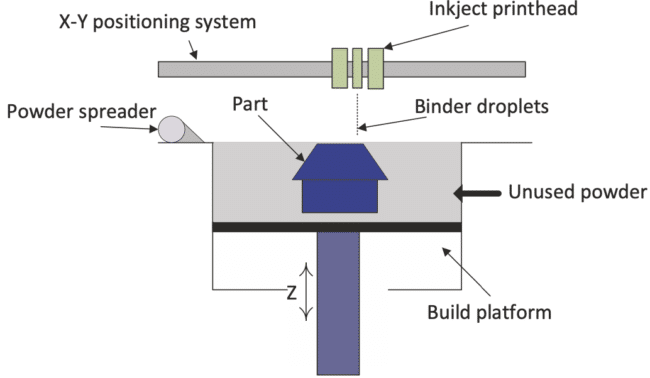
Illustration of Binder Jetting Process (source)
Binder Jetting (BJT) was initially called 3D printing and was developed by a group at MIT. In BJT, a machine uses a print head containing many injection nozzles to print binder droplets onto a platform filled with powder to form a part. Once a layer is formed, the platform lowers, and a new layer of powder is spread across its surface area. This machine then dispenses the binder onto the platform. This process is repeated until the product is built.
Unlike other additive manufacturing processes, Binder Jetting is only concerned with printing a small fraction of the part’s material. The rest of the material is spread on the powder bed using non-BJT methods.
The binder materials used in BJT include calcium sulfate hemihydrate, poly-methyl methacrylate, and colloidal silica binders. The binder jetting process can be used to print binders into metal and ceramic powder beds.
6. Sheet Lamination (SHL)
In Sheet Lamination (SHL), sheet material is cut, stacked to form layers, and bonded to form a part. It is worth pointing out that the sheet material, which can include metal, paper, polymer, and ceramic sheets, can be stacked and then cut or cut and then stacked. In addition, the process can employ a variety of bonding methods that bind the various layers of sheets. These include:
- Adhesive bonding or gluing (the most popular SHL bonding technique)
- Ultrasonic welding
- Clamping
- Thermal bonding
While SHL was one of the earliest commercialized additive manufacturing techniques, its limited success is attributed to material waste, as unused material cannot be reused. This is perhaps because the material not used in the part cannot be reused, leading to wastage.
7. Direct Energy Deposition (DED)
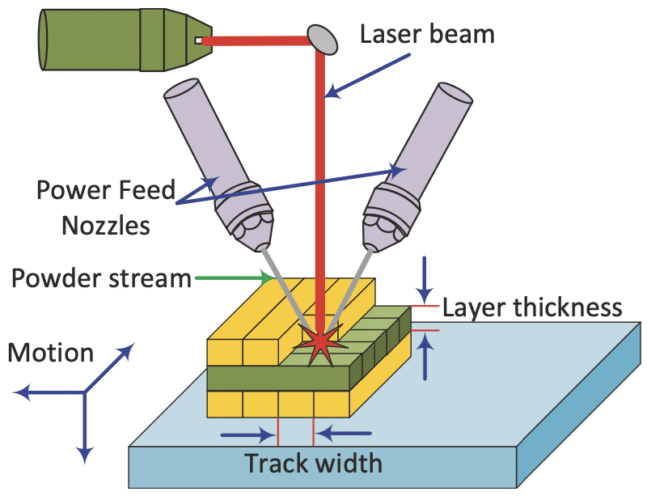
Illustration of the Directed Energy Deposition Process (source)
In Direct Energy Deposition (DED), the material delivered in the form of a wire or powder is melted as it is being deposited, layer upon layer. Unlike other additive manufacturing techniques, which use a number of material types, DED is only applied to metals. The most common type of DED machine uses lasers as the source of heat to melt the metals. They use a deposition head to deposit material onto the substrate, which can be either a flat platform for building new parts or an existing part for adding additional layers.
The deposition head typically combines powder nozzles, sensors, inert gas tubing, and laser optics. The machine’s controller actuates the movement of the deposition head, substrate, or the combined motion of the head and substrate. This relative differential motion controls the deposition of material.
Industrial Applications Redefining Production
The early evolution of AM and the development of AM techniques rest on the shoulders of the medical, aerospace, and automotive industries, which were the early adopters of the technology. These industries’ respective needs led to improvements in additive manufacturing techniques, culminating in what we know and use today. As a result of these efforts, additive manufacturing is applicable in many major industries. We have discussed some of them below.
From a general industry-agnostic perspective, additive manufacturing has redefined production, enabling manufacturing companies in multiple industries to:
- Develop tooling solutions (rapid tooling): AM is ideal for low-volume production of tools
- Produce prototypes (rapid prototyping)
- Create scale models for functional testing applications like flow testing
Additive Manufacturing in the Medical Industry
AM enables the creation of customized solutions such as prosthetics and implants, given clinicians can use patient-specific data stored in scans to create 3D CAD data. Models of complex body parts act as surgical aids, helping surgeons to better visualize the organs and parts and subsequently perform complex surgical procedures. Other applications include organic printing and tissue engineering
Additive Manufacturing in the Construction Industry
For more than a decade now, professionals in the construction industry have used AM techniques to make architectural models. Besides this common application, research on 3D printing methods that can be applied in the construction industry has been on high gear, especially in recent years. As a result of these efforts, gantry systems and large robotic arm systems have been created to fabricate parts using polymers, metals, and aggregate-based materials.
Additive Manufacturing in the Food Industry
The food industry has not shied away from using additive manufacturing. Here, Material Extrusion is the most common additive manufacturing technique. It is used to dispense puree, dough, and chocolate onto a heated platform, where the material solidifies. Other techniques like Binder Jetting and Selective Laser Sintering are also used in the additive manufacture of food.
Additive Manufacturing in the Aerospace Industry
In an industry like aerospace that requires parts that have complex engineered geometries yet have the least possible weight, additive manufacturing has proven to be the go-to fabrication method. AM enabled aerospace companies to build complex parts using the least number of processing steps. Moreover, it supports topology optimization, a mathematical technique that enables manufacturers to place material only where it is needed to support loads. Put simply, additive manufacturing in the aerospace industry produces highly optimized components that are incredibly lighter.
At Boeing, AM has enabled the company to use less materials, produce less waste, and promote the fuel efficiency of its aircraft. AM also helped the company reduce lead time, which has led to a 25%-50% reduction in manufacturing costs. The company has used AM in production for over 30 years. By 2022, it had created 70,000 products using additive manufacturing techniques.
Additive Manufacturing in the Automotive Industry
Automotive companies were the first to deploy many of the additive manufacturing applications that are used today. However, the industry, known for the mass production of cars and parts, does not use AM to produce large volumes of parts. Doing this would obviously take an unnecessarily long time. So, automotive companies have largely restricted additive manufacturing to the fabrication of prototypes as well as the development of tooling, fixtures, and jigs.
Niche automotive companies like Formula 1 racing teams also use additive manufacturing to fabricate parts for their cars. These teams also conduct wind tunnel testing using scale models fabricated through additive manufacturing.
The Unique Identity of Additive Manufacturing
Additive manufacturing is just but one type of fabrication technique. In all, there are four manufacturing/fabrication processes:
- Additive manufacturing: As detailed in this article, additive manufacturing processes join material, layer-by-layer, to form a product whose size is much larger than the feedstock.
- Subtractive manufacturing: In subtractive processes, the final part is smaller in size than the workpiece from which it is fabricated.
- Formative manufacturing: Formative processes use restricting formworks or mechanical forces to form the material into a part with a desired shape.
- Hybrid manufacturing: Hybrid manufacturing processes combine additive and subtractive fabrication methods.
Each of these fabrication processes has distinct properties defining its unique identity. Yet, the distinction between additive manufacturing and 3D printing may not be obvious.
Additive Manufacturing vs. 3D Printing
Additive manufacturing is a broad term covering all processes that build products layer upon layer from 3D CAD data. On the other hand, within the manufacturing industry, 3D printing generally describes the process of fabricating objects by using a print head, nozzle, or any other printer technology to deposit material. Thus, 3DP mostly relates to processes like Binder Jetting and Material Jetting. Usually, this term is associated with machines used for personal or non-industrial purposes. The table below summarizes the differences between additive manufacturing and 3D printing.
|
Additive Manufacturing |
3D Printing |
|
Additive manufacturing covers all techniques that involve building products layer by layer from 3D CAD data |
3D printing describes processes like Binder Jetting and Material Jetting that use printer technology to deposit material |
|
Additive manufacturing is used in industrial settings |
3DP is oriented toward consumer, hobbyist, or household use |
|
AM machines can be quite large, meaning they have a large build volume |
3D printers have a small build volume, |
|
AM machines can build both large and small objects |
3D printers can build small objects |
Based on these differences, it is easy to understand why discussing additive manufacturing goes beyond the limited scope of 3D printing.
Additive Manufacturing and the Digital Workflow
The Industrial Revolution 4.0 or Industry 4.0 has introduced smart manufacturing, bringing digitalization technologies into the manufacturing space and shop floors. The result has been an increase in productivity, better energy optimization, and parts and products that satisfy customer needs. The digitalization technologies include the digital thread, digital twins, generative design and artificial intelligence, the industrial Internet of Things (IIoT), and more.
Today, it is not uncommon for manufacturers and organizations to integrate additive manufacturing with these digitalization technologies. For instance, the United States Department of Defense once had a spare parts problem for some of its old vehicles and aircraft. Whenever they needed a new replacement part, they would discover that the original equipment manufacturer, part supplier, or tooling they required was no longer in business. They also found that to fabricate the parts, they needed the parts’ drawings, which they could not access. To solve the problem, General Electric made digital twins of the aircraft and vehicles. They then used this digital twin to print perfectly fitting parts using additive manufacturing.
What’s more, manufacturers have built digital and IIoT infrastructures that connect various factions of production floors and assembly lines. This infrastructure includes sensors that collect data, facilitating analytics. This data then flows across connections facilitated by a communication framework called the digital thread. In the additive manufacturing domain, the digital thread can help manufacturers harness the full potential of AM technology. For instance, by facilitating data transfer and analytics, the digital thread enables companies to anticipate machine failures and perform predictive maintenance.
Moreover, they can couple the digital twin of the AM machines with the digital thread. This approach would allow them to fabricate replacement parts from the digital replica that fit into the AM machines.
Benefits of Additive Manufacturing
Additive manufacturing offers numerous benefits, including:
- It enables manufacturers to rapidly create physical models of any complexity and subsequently conduct functional tests and experiments
- Additive manufacturing offers the ability to increase part complexity without impacting lead time and cost
- It minimizes the design, manufacturing, and verification of tooling, lowering fixed costs
- Additive manufacturing technologies eliminate costs associated with labor since AM machines do not require part-specific setting up or programming, casting, or machining labor; also, a single person can operate the machines
- The technology reduces material waste and waste disposal costs
- It eliminates material transportation and inventory cost
- AM supports customization because of fewer constraints.
- Additive manufacturing enables companies to change in real time the production capacity to meet market demand
- The fabrication technique simplifies the supply chain
- The Binder Jetting AM technique enables the economical fabrication of standard engineering materials as it does not require high energy, is fast, and relatively inexpensive
Overcoming Challenges and Navigating Barriers
There are certain challenges you are likely to encounter when you use additive manufacturing techniques, the benefits discussed above notwithstanding. These challenges include:
1. Limited Production Volume
Additive manufacturing techniques and machines are not suited for high-volume production. For this reason, automotive companies do not use AM machines to manufacture parts that need to be mass-produced. Instead, they only use the techniques to fabricate prototypes.
2. Complex AM Techniques
AM techniques like MJT for 3D fabrication can be extremely complex. This is because the heads and nozzles in MJT systems dispense the feedstock in the form of liquid material droplets. This deposition must be controlled. What’s more, once deposited, the solidification of the droplets must be controlled. The need for controls at the different stages of fabrication adds layers of complications to the process. While this is just one example, each AM technique has its own level of complication. To overcome this challenge, it is important to undergo training.
3. Material deficiencies
There are three classes of AM machines: liquid-based systems, powder-based systems, and solid-based systems. These categories point to the specificity of the machines in that they can only use certain materials as feedstock. You cannot feed liquid feedstock into a powder-based or solid-based system. The same applies to powder and solid materials. Thus, if you are working with different classes of material, you will have to purchase different AM machines, adding production costs.
4. Industry-Specific Deficiencies
Professionals in the medical field have reported deficiencies in existing AM technologies. These deficiencies relate to how the technologies and techniques are used to build medical models. They arise from the fact that AM machines were not originally developed with the medical field in mind, even though players in the industry were among the early adopters. Rather, they were intended for widespread adoption. Thus, device manufacturers have mostly worked to develop improvements that solve problems for manufacturers rather than the industry-specific problems that medical professionals raise.
5. High Technical Requirements
AM machines – especially larger, more complex machines – require a high degree of technical expertise to fabricate quality parts and objects. But this is not an insurmountable challenge. Companies can continuously train their technicians to handle complex machines.
Conclusion
Additive manufacturing is broader and has a larger scope than 3D printing. While 3DP describes processes that use printer technology, AM covers all techniques that create products from 3D CAD data through layer-by-layer material deposition. For this reason, additive manufacturing includes techniques like vat photopolymerization, powder bed fusion, material extrusion, material jetting, binder jetting, directed energy deposition, and sheet lamination.
These techniques are applied in the medical, aerospace, automotive, construction, and food industries. And thanks to the technological developments brought by Industry 4.0, they can be used with other technologies like digital twins, the industrial Internet of Things, the digital thread, artificial intelligence, and more. As we have touched on above, AM processes offer numerous advantages when used in isolation or with other technologies. Nonetheless, you are likely to encounter some challenges when you deploy additive manufacturing in your organization, but they are easily surmountable
Note: For more information about additive manufacturing, we recommend the book Additive Manufacturing Technologies by Ian Gibson and colleagues, which we have referenced in the writing of this article.

